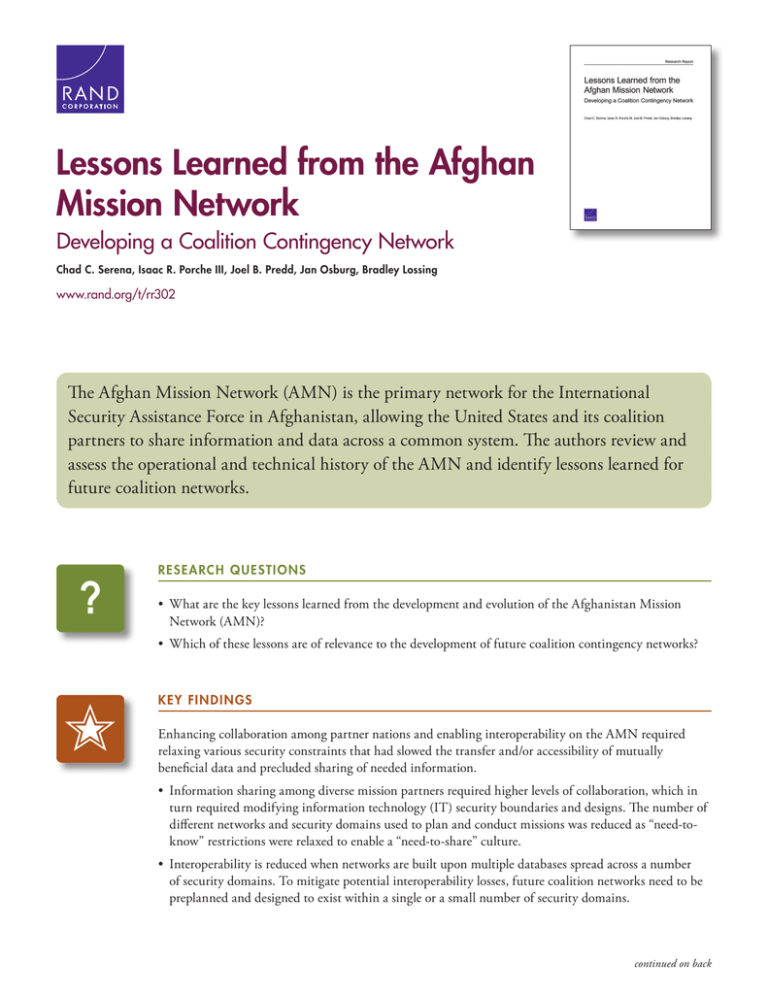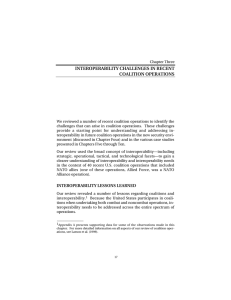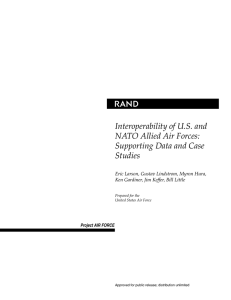Lessons Learned from the Afghan Mission Network Developing a Coalition Contingency Network
advertisement

C O R P O R AT I O N Lessons Learned from the Afghan Mission Network Developing a Coalition Contingency Network Chad C. Serena, Isaac R. Porche III, Joel B. Predd, Jan Osburg, Bradley Lossing www.rand.org/t/rr302 The Afghan Mission Network (AMN) is the primary network for the International Security Assistance Force in Afghanistan, allowing the United States and its coalition partners to share information and data across a common system. The authors review and assess the operational and technical history of the AMN and identify lessons learned for future coalition networks. ? Rese arc h Q u estions • What are the key lessons learned from the development and evolution of the Afghanistan Mission Network (AMN)? • Which of these lessons are of relevance to the development of future coalition contingency networks? ✭ K e y Fin d in gs Enhancing collaboration among partner nations and enabling interoperability on the AMN required relaxing various security constraints that had slowed the transfer and/or accessibility of mutually beneficial data and precluded sharing of needed information. • Information sharing among diverse mission partners required higher levels of collaboration, which in turn required modifying information technology (IT) security boundaries and designs. The number of different networks and security domains used to plan and conduct missions was reduced as “need-toknow” restrictions were relaxed to enable a “need-to-share” culture. • Interoperability is reduced when networks are built upon multiple databases spread across a number of security domains. To mitigate potential interoperability losses, future coalition networks need to be preplanned and designed to exist within a single or a small number of security domains. continued on back Many of the benefits realized from the AMN were the result of a development and testing process focused on documenting user steps for operational tasks conducted in the field. • Operation Enduring Freedom “mission threads” individually and collectively comprised the types of missions conducted throughout Afghanistan and provided the baseline for the data organization, sharing, and analysis at the center of the AMN. • Operation Enduring Freedom “mission threads,” and other commonly defined and understood mission threads, should be used to guide the development of future coalition data-sharing enterprises. Extra-theater testing, assurance, and validation efforts like those conducted by the Joint Interoperability Test Command’s (JITC) Coalition Interoperability Assurance and Validation (CIAV) program enable controlled network experimentation and testing pursuant to network solutions that can later be replicated in theater. • Dedicated Army and Defense Information Systems Agency (DISA) facilities and personnel enabled the rapid testing and integration of a complex and continuously evolving network. These facilities and personnel provided methods for immediately addressing gaps identified in the network. They also provided assessments of technologies prior to their introduction and operational fielding into the AMN enterprise. • The decision to leverage Army and DISA facilities and personnel for network testing and integration marked a turning point in the functional development of the AMN for the following reasons: (1) it freed warfighters to continue with the conduct of their various missions; and (2) it allowed warfighters to take advantage of expertise and systems that might not necessarily be available in theater. To Do R ecomm en dations • A common mission network will likely be needed in every region where the United States conducts coalition operations. • The Army should establish a persistent capacity for the testing and validation of coalition network capabilities and equipment. • Appropriate requirements documents should reflect the information-sharing needs associated with ubiquitous coalition operations. A RRO YO CENT ER RAND Arroyo Center is the Army’s federally funded research and development center for studies and analyses. Its mission is to help Army leaders make decisions that are informed by objective, high-quality analysis. For more information visit Arroyo’s website at www.rand.org/ard.





